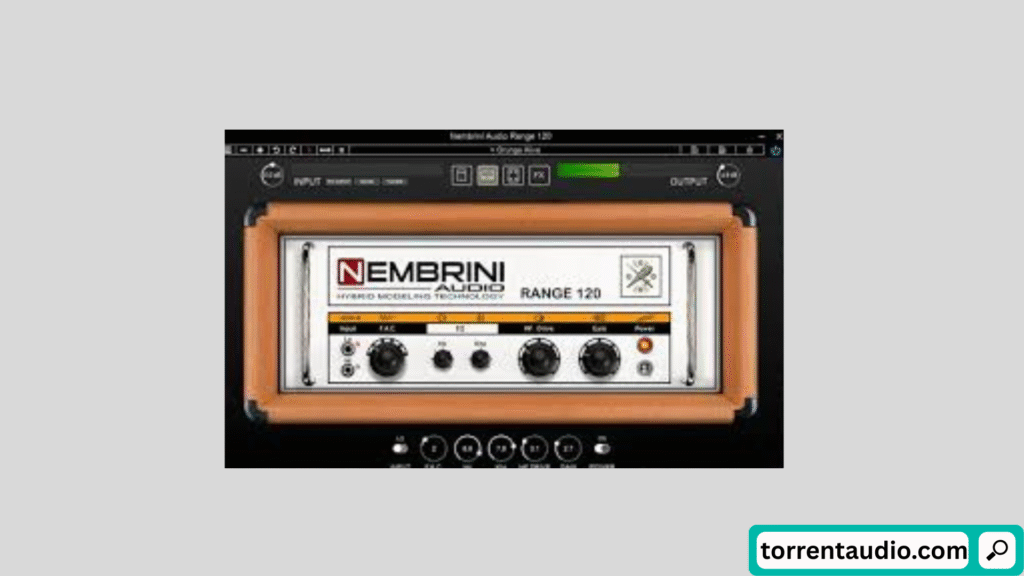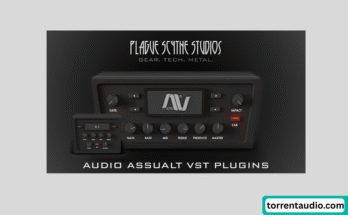Nembrini Audio’s savage rendition of a British head from the 1970s, the NA Range 120, is known for its aggressive cleans, sharp crunch, and rich, saturated overdrive. The unique voicing of the amp is included in this Windows-ready plugin, along with a complete studio signal chain that includes cabinets, microphones, IR loaders, stomps, and post FX, allowing you to go from ideas to album-ready tones without ever leaving your DAW. Range 120 delivers that distinct “big iron” power with contemporary workflow benefits, whether you are tracking vintage rock rhythms, gritty indie sections, or thunderous stoner riffs.
Feature Highlights:
- This genuine amplifier type features the recognizable F.A.C. (Frequency Attenuator Control), a six-position rotary that modifies the voice and mids for rapid tone changes.
- An HF drive is added to the interactive Baxandall tone stack (bass in Hz/treble in kHz) to give it more bite and glitter.
- Similar to the hardware, there are two inputs (High/Low) to select between maximal headroom and earlier saturation.
- Cabinets and IR loader: the capacity to load and blend up to three third-party IRs at once for deep cab construction, together with six carefully chosen cabs, four mic models with placement, and a mixer.
- Noise gate, compressor, doubler, and 808 Octane overdrive (an 808-style circuit with selectable octave-up) are the components that make up the pre-amp stomp section. These components tighten and push the front end. To rearrange, drag and drop.
- Post-amp studio rack: studio compressor, delay-reverb block, and musical EQ for smoothed mixes.
Included is a standalone software for fast re-amping or jamming without a DAW.
What’s New 2025:
- New release and voicing development: The 2025 insertion aims to combine the traditional preamp behavior with current events manufacturing requirements, offering the classic British smell with contemporary routing and cabinet responsiveness.
- IR/cabinet workflow expansion: With a visible IR graph, you may mix up to three IRs simultaneously, allowing you to stack tastes for album-worthy depth (for example, a ribbon blend with a roomier 2×12 and a tighter 4×12).
- Chain of drag-reorderable effects: To adjust space and clarity, you may rearrange the post rack and stomp section as you like. For example, you can relocate EQ after ambience or place compression before overdrive.
- Launch price for the intro: Building a British-voiced toolkit is made simple by the desktop version’s introduction offer. (Check the product page as prices are subject to change.)
Quick Guide:
- Select your gain and input stage: For clearer headroom, start on Low input; switch to High for an earlier breakdown. Adjust the output to fit your mix after setting the gain for the appropriate crunch.
- Modify the amp’s voice: Select your mid contour with the F.A.C. switch, then add bass or treble to make it sweeter. When you need an additional edge to cut through complex arrangements, bring in HF Drive.
- Tighten and stimulate using stomps: Compressor to smooth pick attack, Gate to reduce noise, 808 Octane is used to drive the front end and emphasize lows for a current rock rhythm tone, while Doubler is used for a broad mono-to-stereo spread. Drag to rearrange as necessary.
- Set the microphones and cab: Try combining a dynamic and ribbon mic, adjusting the mic locations for balance, and auditioning the six built-in cabs. Put up to three preferred IRs in the mixer and combine to create distinctive flavors.
- In the rack, polish: From “raw” to “release-ready,” a little post-EQ carving, a little delay-reverb for space, and a studio compressor for density can help.
- Standalone or DAW: For practice and fast inspiration, use the standalone application. For complete session control, use the VST/VST3/AAX plugin on a guitar track.
System Requirements:
- Oss solutions: 64-bit Windows 7 or eventually.
- Processor: Apple Silicon (for macOS) or Intel-compatible; a contemporary 64-bit CPU is advised for Windows.
- RAM: at least 1 GB.
- Formats for plugins: AAX (Audio Units on macOS), VST2, and VST3.
- Mob: Any 64-bit DAW that works.
(Always check the product page for the most up-to-date specifications.)
Download Steps:
- Click Download Installer and Demo on the NA Range 120’s official product page. This gives you access to the Windows installer so you can test it out in your configuration.
- Choose your preferred formats (VST2/VST3/AAX) after running the installation. If your DAW utilizes custom paths, make sure your plugin directories are correct.
- To find new plugins, open your DAW. Add NA Range 120 to a re-amp bus or a guitar track.
- Follow Nembrini’s on-screen directions to activate (an internet connection might be necessary).
- To finish your sound, utilize the F.A.C., tone stack, cabs/IRs, and FX after loading a preset and playing and adjusting.



